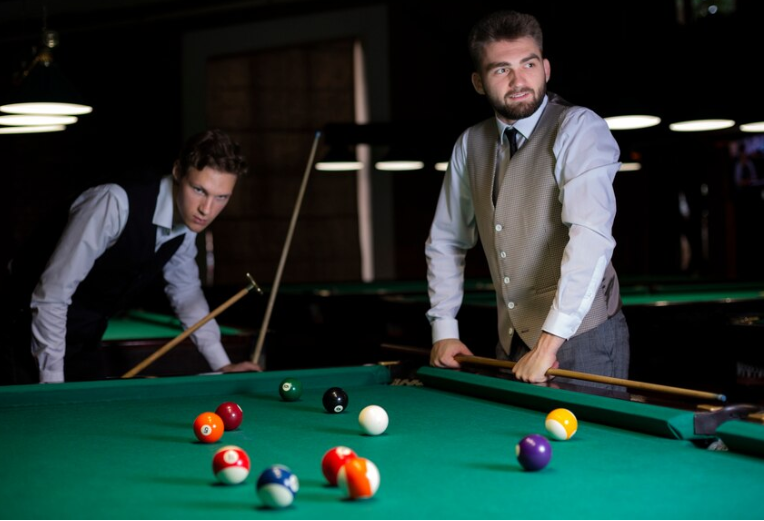A pool table is a significant investment, whether for personal use or a professional setting. Choosing the right one requires careful consideration of key features to ensure it meets your needs, fits your space, and delivers an enjoyable playing experience. This guide will walk you through the essential features to consider when selecting a pool table, helping you make an informed decision.

Size and Dimensions
When evaluating what features to look for in a pool table, size is one of the most critical factors. Pool tables come in various sizes, typically ranging from 7 feet (bar size) to 9 feet (tournament size).
- Space Requirements: Ensure you have enough room for the table and adequate space around it for comfortable gameplay. For example, a standard 8-foot table requires a room size of at least 13 x 17 feet for standard cues.
- Purpose of Use: If you’re buying for casual home use, a 7 or 8-foot table may be suitable. For competitive play, a 9-foot table is preferred.
Consider your room size and the skill level of the players who will use the table most frequently.
Construction Material
The construction of a pool table greatly influences its durability and performance. Key materials to consider include:
Slate Bed
- Slate is the gold standard for pool table surfaces. It provides a smooth, level playing surface and exceptional durability.
- Look for tables with a three-piece slate design for easier leveling and installation.
Frame and Legs
- High-quality tables are constructed with solid hardwood frames and legs, offering superior stability and longevity.
- Avoid tables made from MDF or particleboard, as they are less durable and prone to warping.
Cushions and Rails
- Cushions should be made of natural gum rubber for consistent ball rebound.
- Examine the table’s rails to ensure they are securely attached and offer robust support.
Felt and Playing Surface
The playing surface is covered in felt, which significantly affects gameplay.
- Material: Choose felt made of a wool-nylon blend for a balance of durability and smooth play.
- Weight and Thickness: High-quality felt is thicker and denser, ensuring it lasts longer and provides a consistent playing experience.
Maintenance of the felt is also essential; proper cleaning and care can extend its lifespan.
Design and Aesthetics
A pool table is often a centerpiece in any room, so its design should complement the surrounding décor.
Style
- Traditional tables often feature intricate wood carvings and leather pockets.
- Modern tables may have sleek designs and minimalistic aesthetics.
Finish Options
- Choose a finish that matches your room’s style, such as mahogany, oak, or walnut.
- Opt for finishes that are resistant to scratches and stains to maintain the table’s appearance over time.
Functionality should never be compromised for the sake of aesthetics.
Accessories and Additional Features
When considering what features to look for in a pool table, don’t overlook the importance of accessories and added features.
- Cue Sticks and Racks: Ensure the table includes high-quality cue sticks and a sturdy rack for balls.
- Adjustable Legs: Tables with adjustable leg levelers are ideal for ensuring a flat playing surface on uneven floors.
- Ball Return System: Some tables feature an automatic ball return system, which is convenient and adds a professional touch.
Budget Considerations
Pool tables vary widely in price, influenced by factors like size, material, and brand.
- Entry-Level Tables: Cost-effective models are typically smaller and constructed with MDF. They are best for casual players or those on a budget.
- Mid-Range Tables: These tables often feature slate surfaces and hardwood frames, offering a good balance of quality and affordability.
- High-End Tables: Designed for professional use, these tables boast premium materials and craftsmanship, ensuring top-tier performance and aesthetics.
Determine your budget beforehand, but prioritize quality to ensure long-term satisfaction.
Maintenance and Care
A pool table is an investment, and proper maintenance ensures it remains in excellent condition for years.
- Felt Cleaning: Regularly brush the felt to remove dust and debris. Avoid excessive moisture, as it can damage the surface.
- Slate and Frame Care: Clean the slate with a damp cloth as needed and keep the frame polished to preserve its finish.
- Storage Tips: Avoid placing the table in areas with high humidity or direct sunlight, as these can cause warping and fading.
Brand and Warranty
Selecting a reputable brand ensures quality and reliability.
- Trusted Brands: Look for manufacturers known for producing durable and high-performing pool tables. Read customer reviews and testimonials for insights.
- Warranty Coverage: Check if the table includes a comprehensive warranty that covers defects in materials and craftsmanship.
Final Thoughts
Purchasing a pool table is an exciting endeavor, but it’s essential to consider what features to look for in a pool table before making a decision. Evaluate factors like size, construction material, playing surface, and design to ensure the table meets your requirements. Don’t forget to account for budget, accessories, and maintenance needs.
By keeping these features in mind, you’ll be well on your way to finding the perfect pool table that combines functionality, durability, and aesthetic appeal.





